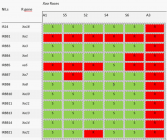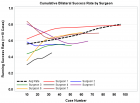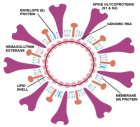Abstract
Research Article
Characterization of senegalese races of Xanthomonas oryzae PV. oryzae to identify resistance genes to use
Tall H*, Tékété C, Comte A, Noba K, Hutin M, Szurek B, Verdier V and Cunnac S
Published: 19 October, 2022 | Volume 6 - Issue 3 | Pages: 135-145
Bacterial blight (BB), is a disease caused by Xanthomonas oryzae PV. oryzae (Xoo), was first reported in Senegal by Trinh in 1980. BB represents a severe threat to rice cultivation in West Africa. Characterizing the pathotypic diversity of bacterial populations is a key to the management of pathogen-resistant varieties. Pathogenicity tests show that all strains are virulent on the susceptible rice variety Azucena, and interact differentially with twelve near-isogenic rice lines, each carrying a single resistance gene. On this rice panel, six races were identified, two of which were previously reported in Mali (A3) and Burkina Faso (A1). Four races (S2, S4, S5, and S6) are described for the first time in Africa. Races A1, isolated in Ndiaye and Ndioum areas is the most prevalent in Senegal. The Xa1 gene controls 100% of the isolates tested and xa5 controls all isolates except S4 strains. The geographical distribution of Xoo races is contrasted. Four races are detected in the North and two in the South East of the country. Race S4 can be a major risk to rice cultivation because strains from this race are the most virulent and can only be controlled by Xa1. To identify local sources of resistance, we screened Xoo strains representative of the various races on twenty-three rice varieties grown by farmers in Senegal. Four rice varieties namely Sahel210, Sangangbye, Dansna2, and Sahel305 effectively control all the isolates tested. Our characterization of the first collection of Senegalese Xoo strains provided insight into the races present in the country and identified sources of resistance in local rice varieties. This information will help design effective breeding programs for resistance to bacterial leaf blight in Senegal.
Read Full Article HTML DOI: 10.29328/journal.jpsp.1001087 Cite this Article Read Full Article PDF
Keywords:
Xanthomonas oryzae PV; Oryzae; Races; IRBB; Rice; Senegal
References
- Chauhan Bhagirath S, Jabran K, Mahajan G. Rice Production Worldwide. Springer. 2017.
- DAPSA n.d. Agricultural Survey Results (Provisional) | Department of Analysis, Forecasting and Agricultural Statistics - DAPSA. http://www.dapsa.gouv.sn/content/statistiques-agricoles. Consulté le 29 octobre 2019. http://www.dapsa.gouv.sn/content/r%C3%A9sultats-enqu%C3%AAte-agricole-2018-pr%C3%A9visionnels. 2018.
- Patricio Mendez del V, Jean-Martin B. Rice in West Africa: dynamics, policies and perspectives. Cahiers Agricultures 2013;22 (5): 336-344 (1). https://doi.org/10.1684/agr.2013.0657.
- Mew TW. Current Status and Future Prospects of Research on Bacterial Blight of Rice. Annual Review of Phytopathology 1987;25(1): 359‑ https://doi.org/10.1146/annurev.py.25.090187.002043.
- Niño-Liu DO, Ronald PC, Bogdanove AJ. Xanthomonas oryzae pathovars: model pathogens of a model crop. Mol Plant Pathol. 2006 Sep;7(5):303-24. doi: 10.1111/j.1364-3703.2006.00344.x. PMID: 20507449.
- George ML, Bustamam M, Cruz WT, Leach JE, Nelson RJ. Movement of Xanthomonas oryzae pv. oryzae in Southeast Asia Detected Using PCR-Based DNA Fingerprinting. Phytopathology. 1997 Mar;87(3):302-9. doi: 10.1094/PHYTO.1997.87.3.302. PMID: 18945173.
- Shu Huang Ou. Commonwealth Mycological Institute Great Britain. Rice Diseases. IRRI. 1985.
- Sukhwinder-Singh, Sodhi M, Vikal Y, George MLC, Bala GS, Mangat GS, Garg M, Sidhu JS, Dhaliwal HSM. DNA Fingerprinting and Virulence Analysis of Xanthomonas Oryzae Pv. Oryzae Isolates from Punjab, Northern India. Euphytica 2003; 130 (1): 107‑ https://doi.org/10.1023/A:1022329024651.
- Awoderv VA, Bangura N, John VT. Incidence, distribution and severity of bacterial diseases on rice in West Africa. Tropical Pest Management 37 (2): 113‑https://doi.org/10.1080/09670879109371553. 1991.
- Trinh TT. New Rice Diseases and Insects in the Senegal River Basin in 1978/79. International Rice Commission Newsletter. 1980;29 (2). https://www.cabdirect.org/cabdirect/abstract/19810581551.
- Hamidou T, Tekete C, Noba K, ousmane K, Sebastien C, Mathilde H, Boris S, Valérie Verdier. Confirmation report of Bacterial blight caused by Xanthomonas oryzae pv. oryzae on rice in Senegal . Plant Disease, novembre. https://doi.org/10.1094/PDIS-07-19-1464-PDN. 2019.
- Köplin R, Arnold W, Hötte B, Simon R, Wang G, Pühler A. Genetics of Xanthan Production in Xanthomonas Campestris: The XanA and XanB Genes Are Involved in UDP-Glucose and GDP-Mannose Biosynthesis. Journal of Bacteriology. 1992;174 (1): 191‑ https://doi.org/10.1128/jb.174.1.191-199.1992.
- Ray SK, Rajeshwari R, Sonti RV. Mutants of Xanthomonas oryzae pv. oryzae deficient in general secretory pathway are virulence deficient and unable to secrete xylanase. Mol Plant Microbe Interact. 2000 Apr;13(4):394-401. doi: 10.1094/MPMI.2000.13.4.394. PMID: 10755302.
- Lindgren PB. The role of hrp genes during plant-bacterial interactions. Annu Rev Phytopathol. 1997;35:129-52. doi: 10.1146/annurev.phyto.35.1.129. PMID: 15012518.
- White FF, Potnis N, Jones JB, Koebnik R. The type III effectors of Xanthomonas. Mol Plant Pathol. 2009 Nov;10(6):749-66. doi: 10.1111/j.1364-3703.2009.00590.x. PMID: 19849782; PMCID: PMC6640274.
- Alfano JR, Collmer A. Type III secretion system effector proteins: double agents in bacterial disease and plant defense. Annu Rev Phytopathol. 2004;42:385-414. doi: 10.1146/annurev.phyto.42.040103.110731. PMID: 15283671.
- Tran TT, Pérez-Quintero AL, Wonni I, Carpenter SCD, Yu Y, Wang L, Leach JE, Verdier V, Cunnac S, Bogdanove AJ, Koebnik R, Hutin M, Szurek B. Functional analysis of African Xanthomonas oryzae pv. oryzae TALomes reveals a new susceptibility gene in bacterial leaf blight of rice. PLoS Pathog. 2018 Jun 4;14(6):e1007092. doi: 10.1371/journal.ppat.1007092. PMID: 29864161; PMCID: PMC6037387.
- Doucouré H, Pérez-Quintero AL, Reshetnyak G, Tekete C, Auguy F, Thomas E, Koebnik R, Szurek B, Koita O, Verdier V, Cunnac S. Functional and Genome Sequence-Driven Characterization of talEffector Gene Repertoires Reveals Novel Variants With Altered Specificities in Closely Related Malian Xanthomonas oryzae oryzae Strains. Front Microbiol. 2018 Aug 6;9:1657. doi: 10.3389/fmicb.2018.01657. PMID: 30127769; PMCID: PMC6088199.
- Gonzalez C, Szurek B, Manceau C, Mathieu T, Séré Y, Verdier V. Molecular and pathotypic characterization of new Xanthomonas oryzae strains from West Africa. Mol Plant Microbe Interact. 2007 May;20(5):534-46. doi: 10.1094/MPMI-20-5-0534. PMID: 17506331.
- Devadath S, Padmanabhan SY. Approaches to Control of Bacterial Blight and Streak Diseases of Rice in India. Bulletin of the Indian Phytopathological Society, no No. 1970;6: 5‑
- Ganeshan G, Manoj Kumar A. Pseudomonas fluorescens, a potential bacterial antagonist to control plant diseases. Journal of Plant Interactions 2005;1 (3): 123‑ https://doi.org/10.1080/17429140600907043.
- Ahmed HU, Finckh MR, Alfonso RF, Mundt CC. Epidemiological effect of gene deployment strategies on bacterial blight of rice. Phytopathology. 1997 Jan;87(1):66-70. doi: 10.1094/PHYTO.1997.87.1.66. PMID: 18945155.
- Tsugufumi O, Yamamoto T, Gurdev S. Khush, Twng-Wah Mew. Breeding of Near-Isogenic Line of Rice With Single Gene for Resistance to Bacterial Blight Pathogen (Xanthomonas compestris pv. oryzae) . Journal of Breeding Studies 1991; 41 (3): 523‑ https://doi.org/10.1270/jsbbs1951.41.523.
- Huang N, Angeles ER, Domingo J, Magpantay G, Singh S, Zhang G, Kumaravadivel N, Bennett J, Khush GS. Pyramiding of Bacterial Blight Resistance Genes in Rice: Marker-Assisted Selection Using RFLP and PCR . Theoretical and Applied Genetics 1997;95 (3): 313‑ https://doi.org/10.1007/s001220050565.
- KINOSHITA T. Report of the committee on gene symbolization, nomenclature and linkage groups. Rice Genet. Newslett. 1990;7: 16‑
- Rao KK, Lakshminarasu M, Jena KK. DNA markers and marker-assisted breeding for durable resistance to bacterial blight disease in rice. Biotechnol Adv. 2002 Apr;20(1):33-47. doi: 10.1016/s0734-9750(02)00002-2. PMID: 14538061.
- Cheema KK, Grewal NK, Vikal Y, Sharma R, Lore JS, Das A, Bhatia D, Mahajan R, Gupta V, Bharaj TS, Singh K. A novel bacterial blight resistance gene from Oryza nivara mapped to 38 kb region on chromosome 4L and transferred to Oryza sativa L. Genet Res (Camb). 2008 Oct;90(5):397-407. doi: 10.1017/S0016672308009786. PMID: 19061530.
- Mew TW. International Rice Research Institute, C. M. Vera Cruz, et E. S. Medalla. 1992. Changes in Race Frequency of Xanthomonas Oryzae Pv. Oryzae in Response to Rice Cultivars Planted in the Philippines. Plant Disease (USA). http://agris.fao.org/agris-search/search.do?recordID=US9317148.
- Adhikari, Tika B, Mew TW, Leach JE. Genotypic and Pathotypic Diversity in Xanthomonas oryzae pv. oryzae in Nepal . PhytopathologyTM 1999;89 (8): 687‑ https://doi.org/10.1094/PHYTO.1999.89.8.687.
- Lindsay T, Koebnik R, Valerie V, Jan E. Leach. The Genomics of Xanthomonas Oryzae . In Genomics of Plant-Associated Bacteria, édité par Dennis C. Gross, Ann Lichens-Park, Chittaranjan Kole, 2014 ;127‑ Berlin, Heidelberg: Springer. https://doi.org/10.1007/978-3-642-55378-3_6.
- Tekete C, Cunnac S, Doucouré H, Dembele M, Keita I, Sarra S, Dagno K, Koita O, Verdier V. Characterization of New Races of Xanthomonas oryzaeoryzae in Mali Informs Resistance Gene Deployment. Phytopathology. 2020 Feb;110(2):267-277. doi: 10.1094/PHYTO-02-19-0070-R. Epub 2019 Dec 19. PMID: 31464159.
- Lang JM, Hamilton JP, Diaz MGQ, Van Sluys MA, Burgos MRG, Vera Cruz CM, Buell CR, Tisserat NA, Leach JE. Genomics-Based Diagnostic Marker Development for Xanthomonas oryzae pv. oryzae and X. oryzae pv. oryzicola. Plant Dis. 2010 Mar;94(3):311-319. doi: 10.1094/PDIS-94-3-0311. PMID: 30754246.
- Quibod IL, Perez-Quintero A, Booher NJ, Dossa GS, Grande G, Szurek B, Vera Cruz C, Bogdanove AJ, Oliva R. Effector Diversification Contributes to Xanthomonas oryzae pv. oryzae Phenotypic Adaptation in a Semi-Isolated Environment. Sci Rep. 2016 Sep 26;6:34137. doi: 10.1038/srep34137. PMID: 27667260; PMCID: PMC5035989.
- Kauffman HE. An improved technique for evaluat-ing resistance of rice varieties to Xanthomonas oryzae. Plant Dis. Rep 1973;57: 537‑
- Debabrata N, Bose LK, Singh UD, Sanjay S, Parsuram Nayak sd. Measurement of Genetic Diversity of Virulence in Populations of Xanthomonas Oryzae , 14.
- Leland W. Michael Friendly. 2009. The History of the Cluster Heat Map. The American Statistician 63 (2): 179‑ https://doi.org/10.1198/tas.2009.0033.
- Adhikari TB, Mew TW, Teng PS. Phenotypic Diversity of Xanthomonas Oryzae Pv. Oryzae in Nepal. Plant Disease (USA). http://agris.fao.org/agris-search/search.do?recordID=US9434820. 1994.
- Takahito N, Chengyun Li, Jiarui Li, Hirokazu Ochiai, Kazuo Ise, Hisatoshi Kaku. Pathogenic Diversity of Xanthomonas oryzae pv. oryzae Strains from Yunnan Province, China . Japan Agricultural Research Quarterly: JARQ 2001;35 (2): 97‑ https://doi.org/10.6090/jarq.35.2.
- Hinda d. Création de résistance à large spectre contre la bactériose foliaire du riz au Mali . Thesis, Montpellier. http://www.theses.fr/2017MONTT100. 2017.
- Wonni Issa. Les bactérioses du riz dues à Xanthomonas oryzae au Burkina Faso: Diversité identification de sources de résistance adaptées. PhD Thesis, Montpellier 2. 2013.
- Yu Y, Streubel J, Balzergue S, Champion A, Boch J, Koebnik R, Feng J, Verdier V, Szurek B. Colonization of rice leaf blades by an African strain of Xanthomonas oryzae pv. oryzae depends on a new TAL effector that induces the rice nodulin-3 Os11N3 gene. Mol Plant Microbe Interact. 2011 Sep;24(9):1102-13. doi: 10.1094/MPMI-11-10-0254. PMID: 21679014.
- Djedatin G, Ndjiondjop MN, Mathieu T, Cruz CMV, Sanni A, Ghesquière A, Verdier V. Evaluation of African Cultivated Rice Oryza glaberrima for Resistance to Bacterial Blight. Plant Dis. 2011 Apr;95(4):441-447. doi: 10.1094/PDIS-08-10-0558. PMID: 30743359.
- Wen-Ling D, Heng-An Lin, Yu-Cyuan S, Kuo CH, Tzeng JU, Li-yu D. Liu, Shu-Tzu Huang, Chi-Ming Huang, Chia-Lin Chung. Genotypic and Pathotypic Diversity of Xanthomonas oryzae pv. oryzae Strains in Taiwan . Journal of Phytopathology 2016;164 (10): 745‑ https://doi.org/10.1111/jph.12495.
- Wang GL, Song WY, Ruan DL, Sideris S, Ronald PC. The cloned gene, Xa21, confers resistance to multiple Xanthomonas oryzae pv. oryzae isolates in transgenic plants. Mol Plant Microbe Interact. 1996 Dec;9(9):850-5. doi: 10.1094/mpmi-9-0850. PMID: 8969533.
- Issa W. Evaluation of Elite Rice Varieties Unmasks New Sources of Bacterial Blight and Leaf Streak Resistance for Africa. Rice Research: Open Access. 2016; 4 (1). https://doi.org/10.4172/2375-4338.1000162.
Figures:

Figure 1

Figure 2

Figure 3

Figure 4

Figure 5

Figure 6
Similar Articles
-
Impact of Calcium Phosphate Nanoparticles on Rice PlantHrishikesh Upadhyaya*,Lutfa Begum,Bishal Dey,P K Nath,S K Panda. Impact of Calcium Phosphate Nanoparticles on Rice Plant. . 2017 doi: 10.29328/journal.jpsp.1001001; 1: 001-010
-
Physiological impact of Zinc nanoparticle on germination of rice (Oryza sativa L) seedUpadhyaya H*,Roy H,Shome S,Tewari S,Bhattacharya MK,Panda SK. Physiological impact of Zinc nanoparticle on germination of rice (Oryza sativa L) seed . . 2017 doi: 10.29328/journal.jpsp.1001008; 1: 062-070
-
Use of essential oils as new food preservatives (Case: Eucalyptus grandis and Eucalyptus crebra)Sendanyoye Marcel*. Use of essential oils as new food preservatives (Case: Eucalyptus grandis and Eucalyptus crebra). . 2018 doi: 10.29328/journal.jpsp.1001023; 2: 083-090
-
Primer Pairs for Rice (Oryza sativa L.) Bisulfite Sequencing StudiesMehmet Karaca*,Ayse Gul Ince. Primer Pairs for Rice (Oryza sativa L.) Bisulfite Sequencing Studies. . 2018 doi: 10.29328/journal.jpsp.1001024; 2: 091-098
-
Causal agents of Post-harvest Rot of Pumpkin (Cucurbita pepo L.) and their control using Indigenous Practices in Hong, Adamawa StateAnjili SM*,Kazi N,Chimbekujwo IB. Causal agents of Post-harvest Rot of Pumpkin (Cucurbita pepo L.) and their control using Indigenous Practices in Hong, Adamawa State. . 2019 doi: 10.29328/journal.jpsp.1001033; 3: 062-066
-
Effect of Khaya Senegalensis Bark and Oil on Post-Harvest Fungal Agents of Groundnut Seeds Rot in Adamawa State, NigeriaChannya FK*,Asama P,Anjili SM . Effect of Khaya Senegalensis Bark and Oil on Post-Harvest Fungal Agents of Groundnut Seeds Rot in Adamawa State, Nigeria. . 2019 doi: 10.29328/journal.jpsp.1001035; 3: 076-080
-
Comprehensive phenotypic characterization and genetic distinction of distinct goosegrass (Eleusine indica L. Gaertn.) ecotypesRobert A Kerr*,Tatyana Zhebentyayeva,Christopher Saski,Lambert B McCarty. Comprehensive phenotypic characterization and genetic distinction of distinct goosegrass (Eleusine indica L. Gaertn.) ecotypes. . 2019 doi: 10.29328/journal.jpsp.1001038; 3: 095-100
-
Potential of Pleurotus sajor-caju compost for controlling Meloidogyne incognita and improve nutritional status of tomato plantsSherin FA Awd Allah*,Doaa M Mostafa,Eman FA Awad-Allah. Potential of Pleurotus sajor-caju compost for controlling Meloidogyne incognita and improve nutritional status of tomato plants. . 2019 doi: 10.29328/journal.jpsp.1001042; 3: 118-127
-
Silicon rates and beneficial microorganism on blast suppression and productivity of upland riceAlan Carlos Alves de Souza*,Eduardo Alves,Marta Cristina Corsi de Filippi,Adriano Stephan Nascente,Anne Sitarama Prabhu. Silicon rates and beneficial microorganism on blast suppression and productivity of upland rice. . 2021 doi: 10.29328/journal.jpsp.1001057; 5: 020-027
-
Mitigation and adaptation to climate change of plant pathogensFrancesco Lops*. Mitigation and adaptation to climate change of plant pathogens. . 2022 doi: 10.29328/journal.jpsp.1001082; 6: 101-102
Recently Viewed
-
Investigate the Effect of Coating Concentration and Coating Thickness on the Anti-microbial Properties of Polycarbonate SheetSaleh Alkarri. Investigate the Effect of Coating Concentration and Coating Thickness on the Anti-microbial Properties of Polycarbonate Sheet. Ann Biomed Sci Eng. 2024: doi: 10.29328/journal.abse.1001029; 8: 011-020
-
The Importance of the Concept of Acute Pneumonia for Choosing the Principles of its Treatment and ResultsIgor Klepikov*. The Importance of the Concept of Acute Pneumonia for Choosing the Principles of its Treatment and Results. J Pulmonol Respir Res. 2024: doi: 10.29328/journal.jprr.1001051; 8: 003-008
-
Prospective Coronavirus Liver Effects: Available KnowledgeAvishek Mandal*. Prospective Coronavirus Liver Effects: Available Knowledge. Ann Clin Gastroenterol Hepatol. 2023: doi: 10.29328/journal.acgh.1001039; 7: 001-010
-
Adult Neurogenesis: A Review of Current Perspectives and Implications for Neuroscience ResearchAlex, Gideon S*,Olanrewaju Oluwaseun Oke,Joy Wilberforce Ekokojde,Tolulope Judah Gbayisomore,Martina C. Anene-Ogbe,Farounbi Glory,Joshua Ayodele Yusuf. Adult Neurogenesis: A Review of Current Perspectives and Implications for Neuroscience Research. J Neurosci Neurol Disord. 2024: doi: 10.29328/journal.jnnd.1001102; 8: 106-114
-
Plant growth, Yield and Leaf Nutritional value of Jute (Corchorus olitorius L.) as Influenced by Banana Peel levels under Salt Stress conditions in Coastal region of CameroonMathias Julien Hand*,Chimène Fanta Abib,Kingsley Mbi Tabi,Alphonse Ervé Nouck,Libert Brice Tonfack,Victor Désiré Taffouo,Emmanuel Youmbi. Plant growth, Yield and Leaf Nutritional value of Jute (Corchorus olitorius L.) as Influenced by Banana Peel levels under Salt Stress conditions in Coastal region of Cameroon. J Plant Sci Phytopathol. 2024: doi: 10.29328/journal.jpsp.1001145; 8: 131-140
Most Viewed
-
Evaluation of Biostimulants Based on Recovered Protein Hydrolysates from Animal By-products as Plant Growth EnhancersH Pérez-Aguilar*, M Lacruz-Asaro, F Arán-Ais. Evaluation of Biostimulants Based on Recovered Protein Hydrolysates from Animal By-products as Plant Growth Enhancers. J Plant Sci Phytopathol. 2023 doi: 10.29328/journal.jpsp.1001104; 7: 042-047
-
Sinonasal Myxoma Extending into the Orbit in a 4-Year Old: A Case PresentationJulian A Purrinos*, Ramzi Younis. Sinonasal Myxoma Extending into the Orbit in a 4-Year Old: A Case Presentation. Arch Case Rep. 2024 doi: 10.29328/journal.acr.1001099; 8: 075-077
-
Feasibility study of magnetic sensing for detecting single-neuron action potentialsDenis Tonini,Kai Wu,Renata Saha,Jian-Ping Wang*. Feasibility study of magnetic sensing for detecting single-neuron action potentials. Ann Biomed Sci Eng. 2022 doi: 10.29328/journal.abse.1001018; 6: 019-029
-
Physical activity can change the physiological and psychological circumstances during COVID-19 pandemic: A narrative reviewKhashayar Maroufi*. Physical activity can change the physiological and psychological circumstances during COVID-19 pandemic: A narrative review. J Sports Med Ther. 2021 doi: 10.29328/journal.jsmt.1001051; 6: 001-007
-
Pediatric Dysgerminoma: Unveiling a Rare Ovarian TumorFaten Limaiem*, Khalil Saffar, Ahmed Halouani. Pediatric Dysgerminoma: Unveiling a Rare Ovarian Tumor. Arch Case Rep. 2024 doi: 10.29328/journal.acr.1001087; 8: 010-013

HSPI: We're glad you're here. Please click "create a new Query" if you are a new visitor to our website and need further information from us.
If you are already a member of our network and need to keep track of any developments regarding a question you have already submitted, click "take me to my Query."




















































































































































